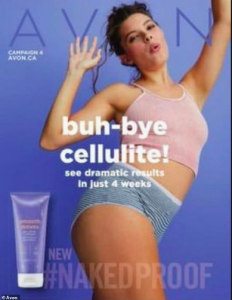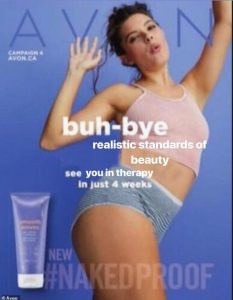
This ad, created by the makeup conglomerate Avon, is advertising for a cream that reduces the appearance of cellulite. In the ad, a woman is seen posing candidly mid-dance with her hair in a messy up-do. Her legs, a common area in which cellulite is usually developed, are exposed and look smooth and tanned. This woman is also relatively plus-sized when compared to the average model that consumers are used to seeing in ads; especially in attire that show to be quite revealing. The model choice made by Avon gives the consumer the illusion that Avon is advocating for body-positivity, despite the message that they are communicating surrounding the removal of cellulite. The message itself is promoting an ‘ideal’ body type, one without marks or dimples or cellulite whilst subtly including the nuances of the body positivity movement into the ad with the use of the plus sized model as well as her care-free stance and casual undergarments. The clues that allude to the ‘body positivity’ movement paired with the body-shaming message of the ad itself proves to be quite ironic as the message of the ad positions itself aversive to the visual cues of the ad. Assuming that the natural human body needs to be fixed, or smoothed over with a cream creates unrealistic beauty standards for women’s bodies. In this example, cellulite is being shown as something that needs to be removed with the expression “Buh-Bye!”. Ads that target the self-created ‘problem areas’ of women create an environment of self-doubt, and insecurity which can later be developed into a psychological condition called Body Dysmorphia or general insecurity and body image issues.

In this reconstruction, I wanted to highlight the changed standard of beauty that this ad creates, as well their lasting effects of public body shaming. Ads that portray skin that is perpetually tanned, smooth, hairless, and without marks contribute to the shifting of societal beauty standards. These standards include what is acceptable, what is not, and what eventually becomes normalized. As a result, it creates a dichotomic relationship between ‘realistic standards of beauty’, and ‘societal standards of beauty’. I highlighted this with the jamming of this ad by substituting ‘cellulite’ with ‘realistic standards of beauty’. The expression “buh-bye realistic standards of beauty” draws attention to the shifting of standards of beauty by commenting on the ‘realness’ of a woman’s body in consumed media. The normalization of a constant upkeep, and being continuously beautified lays way to the diminishing image of how a woman’s body looks like, in reality. By advertising a product that aims to remove cellulite, Avon is in turn suggesting that cellulite is ‘wrong’ or ‘ugly’ to have. What replaces this is the the cellulite-less leg that Avon hails as a new standard of beauty; one that is based on society’s expectation of what beauty is. The second part of this jamming reads ‘see you in therapy in just 4 weeks’. This comments on the rapid deterioration of one’s psychological health due to conditions such as Body Dysmorphia or insecurity in general. Conditions such as this could hinder one from participating in social endeavours due to the lack of confidence in themselves as well as the negative way in which they perceive themselves.